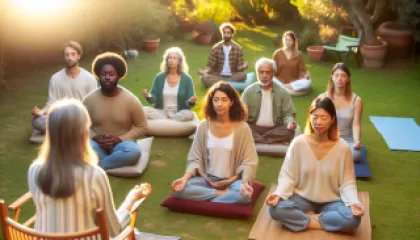Maximizing Mental Clarity: The Ultimate Guide to Harnessing the Benefits of Daydreaming
Do you ever find yourself drifting off into a daydream, lost in a world of imagination and possibilities? While daydreaming is often seen as a distraction or a waste of time, it turns out that there are actually numerous benefits to indulging in a little mental wandering. In fact, daydreaming can be a powerful tool for enhancing mental clarity and unlocking creativity.
The Power of Daydreaming
Daydreaming is a form of spontaneous and self-generated thought that allows our minds to wander freely. It involves creating vivid mental images and scenarios, often unrelated to the present moment. Contrary to popular belief, daydreaming is not a sign of laziness or disengagement. Rather, it is a natural function of the human mind that serves several important purposes.
One of the primary functions of daydreaming is to promote problem-solving and creative thinking. When we allow our minds to wander, we activate different areas of the brain that are associated with imagination, memory, and emotion. This unique neural activity can lead to novel insights and innovative solutions to complex problems.
In addition to fostering creativity, daydreaming also plays a crucial role in our emotional well-being. It provides an opportunity for reflection, self-discovery, and emotional processing. By allowing ourselves to explore our inner thoughts and desires, we can gain a deeper understanding of ourselves and our goals, leading to greater personal fulfillment and happiness.
The Benefits of Creative Visualization
One powerful aspect of daydreaming is the ability to engage in creative visualization. Creative visualization is a technique that involves deliberately creating mental images of specific outcomes or desired experiences. It is a form of guided daydreaming that harnesses the power of our imagination to manifest our goals and aspirations.
When we engage in creative visualization, we activate the same neural pathways that are involved in actual experiences. This means that our brains perceive these imagined scenarios as real, leading to a variety of benefits. Research has shown that regularly practicing creative visualization can enhance motivation, improve performance, and increase self-confidence.
Furthermore, creative visualization has been found to have a positive impact on physical health. By visualizing ourselves engaged in healthy behaviors or experiencing optimal well-being, we can stimulate the release of neurotransmitters and hormones that support our immune system, reduce stress levels, and promote overall wellness.
The Role of Daydreaming in Mental Clarity
While daydreaming may seem like a form of escapism, it can actually help improve our focus and mental clarity. When we allow our minds to wander, we give our brain a break from constant external stimuli and cognitive tasks, allowing it to recharge and replenish its cognitive resources.
Research has shown that brief periods of daydreaming can improve our ability to concentrate and problem-solve. By giving ourselves permission to take short mental breaks throughout the day, we can prevent mental fatigue and enhance our overall cognitive functioning.
Daydreaming also allows us to process and consolidate information more effectively. When we encounter new information or ideas, our minds need time to integrate this knowledge and make sense of it. Daydreaming provides a space for this integration process, allowing us to connect new concepts with existing knowledge and form deeper insights.
How to Harness the Benefits of Daydreaming
If you're interested in maximizing the benefits of daydreaming and harnessing its power for mental clarity, here are some practical tips to get started:
- Schedule dedicated daydreaming time: Set aside specific periods in your day for intentional daydreaming. This could be during your morning commute, lunch break, or before bedtime. By giving yourself permission to daydream, you can fully immerse yourself in the experience without feeling guilty or distracted.
- Create a conducive environment: Find a quiet and comfortable space where you can relax and let your mind wander. Create a cozy corner with pillows, blankets, and soft lighting to enhance your daydreaming sessions.
- Engage in creative activities: Stimulate your imagination by engaging in creative activities such as drawing, painting, writing, or playing a musical instrument. These activities can serve as a springboard for your daydreaming adventures.
- Practice mindfulness: Cultivate a mindfulness practice to help you become more aware of your thoughts and emotions. Mindfulness allows you to observe your daydreams without judgment, enabling you to gain valuable insights from your inner world.
- Set intentions for your daydreams: Before diving into a daydreaming session, set clear intentions for what you hope to achieve or explore. This will help guide your mental wanderings and ensure that they align with your goals and values.
The Journey of Self-Discovery
Embarking on a journey of daydreaming and creative visualization can be a transformative experience. By allowing ourselves to explore the depths of our imagination, we open the door to endless possibilities and untapped potential.
Daydreaming is not merely a form of mental escapism, but rather a powerful tool for personal growth and self-discovery. It can help us gain clarity about our desires, uncover hidden talents, and ignite our passion for life.
So, the next time you find yourself drifting off into a daydream, embrace it. Embrace the power of your imagination and the incredible benefits that daydreaming can offer. Allow yourself to wander through the realms of creativity, and watch as your mental clarity and overall well-being soar to new heights.
Sources:
- Kaufman, S. B. (2013). Ungifted: Intelligence Redefined.
- Klinger, E. (2009). "Daydreaming and fantasy." Oxford Handbook of Positive Psychology.
- Baird, B., et al. (2011). "Inspired by distraction: Mind wandering facilitates creative incubation." Psychological Science.
- Oettingen, G., et al. (2001). "Mental contrasting and goal commitment: The mediating role of energization." Personality and Social Psychology Bulletin.
- Segerstrom, S. C., et al. (2015). "Optimism and attentional bias for negative and positive stimuli." Emotion.






